Kura Clover Living Mulch Reduces Fertilizer N Requirements and Increases Profitability of Maize
Abstract
1. Introduction
2. Materials and Methods
2.1. Site Description
2.2. Experimental Design
2.3. Agronomic Management
2.4. Crop Sampling and Analysis
2.5. Residual Soil Nitrogen
2.6. Economic Calculations
2.7. Data Analysis
3. Results
3.1. First-Year Maize
3.2. Second-Year Maize
3.3. Economic Performance
4. Discussion
5. Conclusions
Author Contributions
Funding
Acknowledgments
Conflicts of Interest
Appendix A
| Input (Unit) | $ unit−1 | $ ha−1 † |
|---|---|---|
| Land | - | 500 |
| Fertilizer P ‡ (kg) | 0.86 | 57.84 |
| Fertilizer K ║ (kg) | 0.60 | 32.28 |
| Fertilizer Application | - | 8.90 |
| Seed (1000 seeds) | 3.26 | 280.36 |
| Planting | - | 26.69 |
| Herbicide | - | 69.19 |
| Insecticide | - | 57.58 |
| Spraying | - | 10.38 |
| Harvest | - | 73.14 |
| Labor | - | 96.87 |
| Miscellaneous | - | 22.24 |
| Total | 1235.47 |
References
- Zemenchik, R.A.; Albrecht, K.A.; Boerboom, C.M.; Lauer, J.G. Corn production with kura clover as a living mulch. Agron. J. 2000, 92, 698–705. [Google Scholar] [CrossRef]
- Affeldt, R.P.; Albrecht, K.A.; Boerboom, C.M.; Bures, E.J. Integrating Herbicide-Resistant Corn Technology in a Kura Clover Living Mulch System. Agron. J. 2004, 96, 247–251. [Google Scholar] [CrossRef]
- Pedersen, P.; Bures, E.J.; Albrecht, K.A. Soybean production in a kura clover living mulch system. Agron. J. 2009, 101, 653–656. [Google Scholar] [CrossRef]
- Grabber, J.H.; Jokela, W.E.; Lauer, J.G. Soil nitrogen and forage yields of corn grown with clover or grass companion crops and manure. Agron. J. 2014, 106, 952–961. [Google Scholar] [CrossRef]
- Siller, A.R.S.; Albrecht, K.A.; Jokela, W.E. Soil erosion and nutrient runoff in corn silage production with Kura clover living mulch and winter rye. Agron. J. 2016, 108, 989–999. [Google Scholar] [CrossRef]
- Ochsner, T.E.; Albrecht, K.A.; Schumacher, T.W.; Baker, J.M.; Berkevich, R.J. Water balance and nitrate leaching under corn in kura clover living mulch. Agron. J. 2010, 102, 1169–1178. [Google Scholar] [CrossRef]
- Schmer, M.R.; Brown, R.M.; Jin, V.L.; Mitchell, R.B.; Redfearn, D.D. Corn Residue Use by Livestock in the United States. Agric. Environ. Lett. 2017, 2, 1–4. [Google Scholar] [CrossRef]
- USDA National Agricultural Statistics Service. Quick Stats; USDA: Washington, DC, USA, 2018.
- Wilhelm, W.W.; Johnson, J.M.F.; Karlen, D.L.; Lightle, D.T. Corn stover to sustain soil organic carbon further constrains biomass supply. Agron. J. 2007, 99, 1665–1667. [Google Scholar] [CrossRef]
- Johnson, J.M.F.; Strock, J.S.; Tallaksen, J.E.; Reese, M. Corn stover harvest changes soil hydrology and soil aggregation. Soil Tillage Res. 2016, 161, 106–115. [Google Scholar] [CrossRef]
- Baker, J.M. Long Term Affects of Kura Clover Living Mulch on Soil Physical Properties; Working Paper; University of Minnesota: St. Paul, MN, USA, 2019. [Google Scholar]
- Pratt, M.R.; Tyner, W.E.; Muth, D.J.; Kladivko, E.J. Synergies between cover crops and corn stover removal. Agric. Syst. 2014, 130, 67–76. [Google Scholar] [CrossRef]
- Ochsner, T.E.; Schumacher, T.W.; Venterea, R.T.; Feyereisen, G.W.; Baker, J.M. Soil Water Dynamics and Nitrate Leaching Under Corn–Soybean Rotation, Continuous Corn, and Kura Clover. Vadose Zo. J. 2017, 17, 1. [Google Scholar] [CrossRef]
- Pearson, C.H.; Brummer, J.E.; Beahm, A.T.; Hansen, N.C. Kura clover living mulch for furrow-irrigated corn in the intermountain west. Agron. J. 2014, 106, 1324–1328. [Google Scholar] [CrossRef]
- Sawyer, J.E.; Pedersen, P.; Barker, D.W.; Ruiz Diaz, D.A.; Albrecht, K. Intercropping corn and kura clover: Response to nitrogen fertilization. Agron. J. 2010, 102, 568–574. [Google Scholar] [CrossRef]
- Alexander, J.R.; Venterea, R.T.; Baker, J.M.; Coulter, J.A. Kura Clover Living Mulch: Spring Management Effects on Nitrogen. Agronomy 2019, 9, 69. [Google Scholar] [CrossRef]
- Dobbratz, M.; Baker, J.M.; Grossman, J.; Wells, M.S.; Ginakes, P. Rotary zone tillage improves corn establishment in a kura clover living mulch. Soil Tillage Res. 2019, 189, 229–235. [Google Scholar] [CrossRef]
- Ricks, N.R. Corn and Soybean Production on Irrigated Coarse-Textured Soils: Integrating Winter Rye and Kura Clover to Reduce Nitrate Leaching. Master’s Thesis, University of Minnesota, Minneapolis, MN, USA, 2019. [Google Scholar]
- Baker, J.M. Vegetative propagation of kura clover: A field-scale test. Can. J. Pln. Sci. 2012, 1245–1251. [Google Scholar] [CrossRef]
- Kaiser, D.E.; Lamb, J.A.; Eliason, R. Fertilizer Guidelines for Agronomic Crops in Minnesota; University of Minnesota Extension: St. Paul, MN, USA, 2011; Volume 1, pp. 1–44. [Google Scholar]
- Bremner, J.M.; Mulvaney, C.S. Nitrogen—Total. In Methods of Soil Analysis; Sparks, D., Ed.; American Society of Agronomy: Madison, WI, USA, 1982; pp. 1085–1089. [Google Scholar]
- Mulvaney, R.L. Nitrogen—Inorganic Forms. In Methods of Soil Analysis Part 3: Chemical Methods; Sparks, D.L., Ed.; American Society of Agronomy: Madison, WI, USA, 1996; pp. 1123–1184. [Google Scholar]
- Hoverstad, T.; Ihlenfeld, W.; Coulter, J.; Reese, C.; Quiring, S.; Hanson, M. Varietal Trial Results: Corn Grain; University of Minnesota Extension: St. Paul, MN, USA, 2017; p. 6. [Google Scholar]
- Hoverstad, T.; Ihlenfeld, W.; Coulter, J.; Reese, C.; Quiring, S.; Hanson, M. Varietal Trial Results: Corn Grain; University of Minnesota Extension: St. Paul, MN, USA, 2018; p. 6. [Google Scholar]
- Edwards, W. Estimating a Value for Corn Stover; Ag Decision Maker—Iowa State University Extension and Outreach: Ames, IA, USA, 2014; Volume 1, pp. 1–4. [Google Scholar]
- Plastina, A. Estimating Costs of Crop Production in 2018; Ag Decision Maker—Iowa State University Extension and Outreach: Ames, IA, USA, 2018; Volume 1, pp. 1–13. [Google Scholar]
- Sawyer, J.E.; Mallarino, A.P. Nutrient Considerations with Corn Stover Harvest; Iowa State University (ISU) Extension and Outreach, ISU: Ames, IA, USA, 2014; pp. 1–3. [Google Scholar]
- Battaglia, M.; Groover, G.; Thomason, W. Harvesting and nutrient replacement costs associated with corn stover removal in Virginia; Virginia Cooperative Extension: Petersburg, VA, USA, 2018; pp. 1–9. [Google Scholar]
- Bates, D.; Maechler, M.; Bolker, B.; Walker, S.; Christensen, R.H.B.; Singmann, H.; Dai, B.; Eigen, C. Package “lme4”. Compr. R Arch. Netw. 2014, 1–123. [Google Scholar]
- Kutner, M.H.; Nachtsheim, C.J.; Neter, J. Applied Linear Regression Models, 4th ed.; McGraw-Hill: New York, NY, USA, 2004; pp. 107–152. [Google Scholar]
- Lenth, R.; Singmann, H.; Love, J.; Buerkner, P.; Herve, M. Package “emmeans”: Estimated Marginal Means, aka Least-Squares Means. Compr. R Arch. Netw. 2019, 1–67. [Google Scholar]
- Plastina, A.; Johanns, A.; Wynne, G. 2019 Iowa Farm Custom Rate Survey. Ag Decis. Mak. 2019, 1–5. [Google Scholar]
- Helmers, M.J.; Lawlor, P.A.; Baker, J.L.; Melvin, S.W.; Lemke, D.W. Temporal Subsurface Flow Patterns from Fifteen Years in North-Central Iowa. Soc. Eng. Agri. Food Bio. Sys. Conf. Proc. 2005, 1–13. [Google Scholar]
- Qi, Z.; Helmers, M.J.; Christianson, R.D.; Pederson, C.H. Nitrate-Nitrogen Losses through Subsurface Drainage under Various Agricultural Land Covers. J. Environ. Qual. 2011, 40, 1578. [Google Scholar] [CrossRef] [PubMed]
- Yost, M.A.; Russelle, M.P.; Coulter, J.A.; Schmitt, M.A.; Sheaffer, C.C.; Randall, G.W. Stand age affects fertilizer nitrogen response in first-year corn following alfalfa. Agron. J. 2015, 107, 486–494. [Google Scholar] [CrossRef]
- Yost, M.A.; Morris, T.F.; Russelle, M.P.; Coulter, J.A. Second-Year Corn after Alfalfa Often Requires No Fertilizer Nitrogen. Agron. J. 2014, 106, 659–669. [Google Scholar] [CrossRef]
- Carpenter-Boggs, L.; Pikul, J.L.; Vigil, M.F.; Riedell, W.E. Soil Nitrogen Mineralization Influenced by Crop Rotation and Nitrogen Fertilization. Soil Sci. Soc. Am. J. 2000, 64, 2038. [Google Scholar] [CrossRef]
- Singh, G.; Schoonover, J.E.; Williard, K.W.J.; Kaur, G.; Crim, J. Carbon and Nitrogen Pools in Deep Soil Horizons at Different Landscape Positions. Soil Sci. Soc. Am. J. 2018, 82, 1512. [Google Scholar] [CrossRef]
- Yost, M.A.; Russelle, M.P.; Coulter, J.A. Field-specific fertilizer nitrogen requirements for first-year corn following alfalfa. Agron. J. 2014, 106, 645–658. [Google Scholar] [CrossRef]
- Peterson, P.R.; Sheaffer, C.C.; Jordan, R.M.; Christians, C.J. Responses of kura clover to sheep grazing and clipping: II. Below-ground morphology, persistence, and total nonstructural carbohydrates. Agron. J. 1994, 86, 660–667. [Google Scholar] [CrossRef]
- Peterson, P.R.; Sheaffer, C.C.; Jordan, R.M.; Christians, C.J. Responses of kura clover to sheep grazing and clipping: I. Yield and forage quality. Agron. J. 1994, 86, 655–660. [Google Scholar] [CrossRef]
- Baributsa, D.N.; Foster, E.F.; Thelen, K.D.; Kravchenko, A.N.; Mutch, D.R.; Ngouajio, M. Corn and cover crop response to corn density in an interseeding system. Agron. J. 2008, 100, 981–987. [Google Scholar] [CrossRef]
- Bolinder, M.A.; Angers, D.A.; Bélanger, G.; Michaud, R.; Laverdière, M.R. Root biomass and shoot to root ratios of perennial forage crops in eastern Canada. Can. J. Plant Sci. 2011, 82, 731–737. [Google Scholar] [CrossRef]
- Kaiser, D.E.; Pagliari, P. Understanding phosphorus fertilizers|UMN Extension. Available online: https://extension.umn.edu/phosphorus-and-potassium/understanding-phosphorus-fertilizers#corn-624160 (accessed on 2 June 2019).
- Kaiser, D.E.; Rosen, C.J. Potassium for crop production|UMN Extension. Available online: https://extension.umn.edu/phosphorus-and-potassium/potassium-crop-production#corn-and-small-grain-603411 (accessed on 2 June 2019).

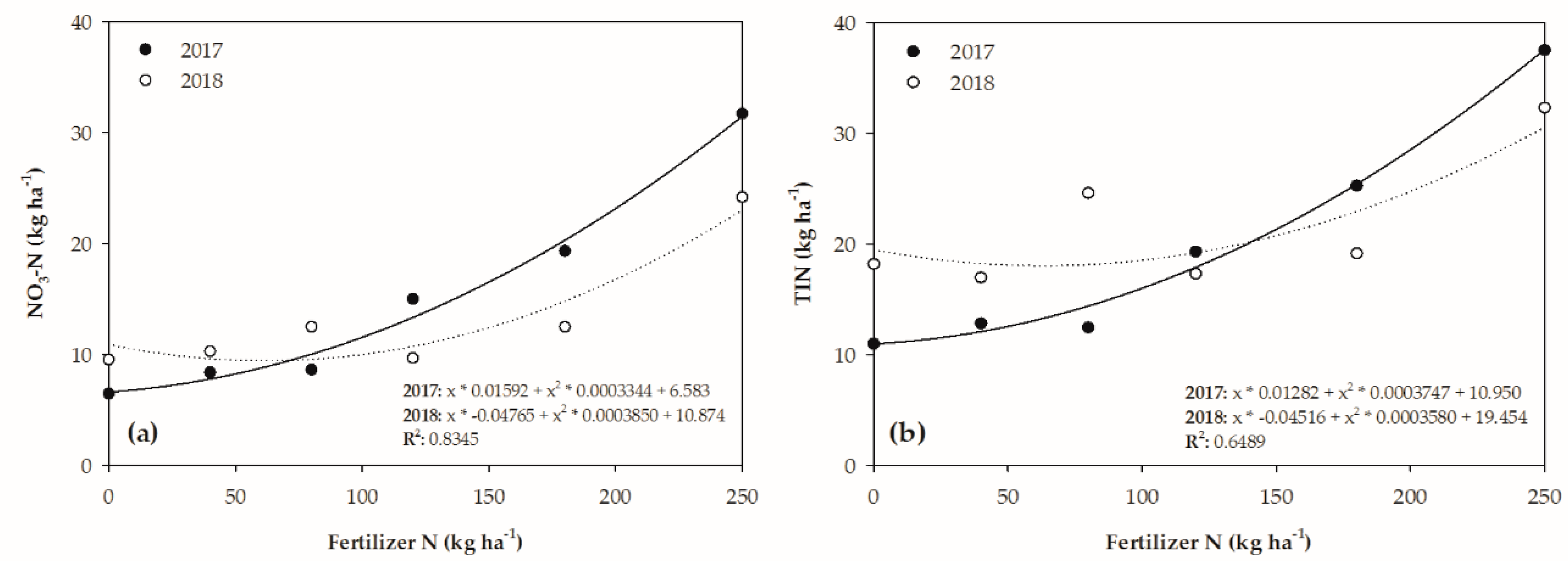
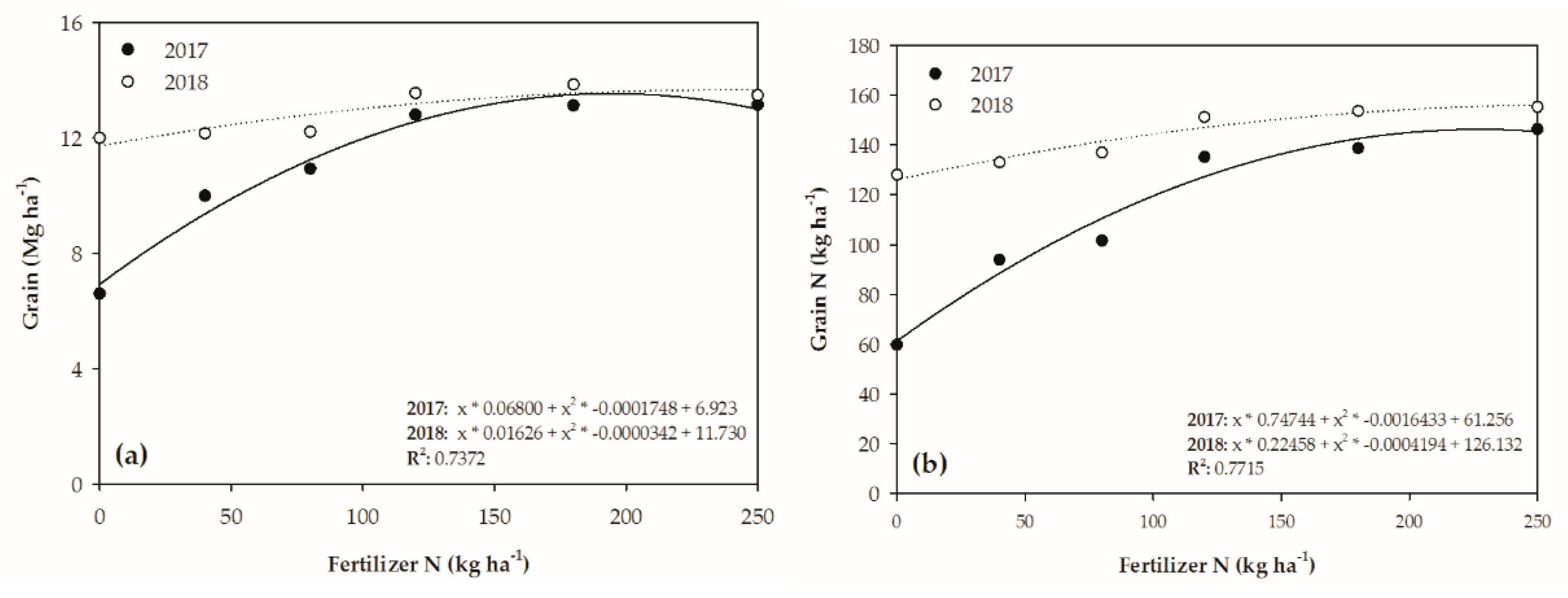
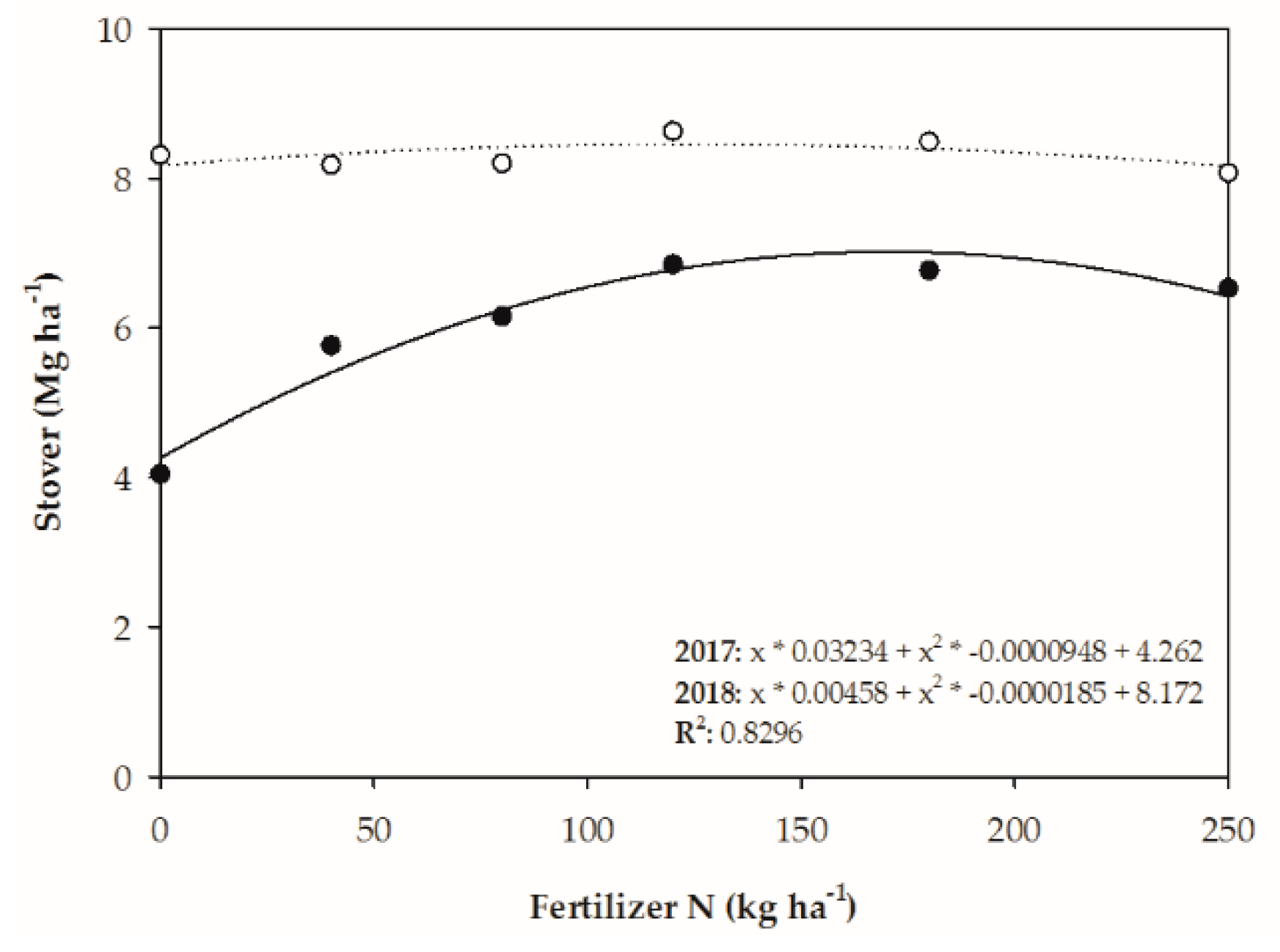
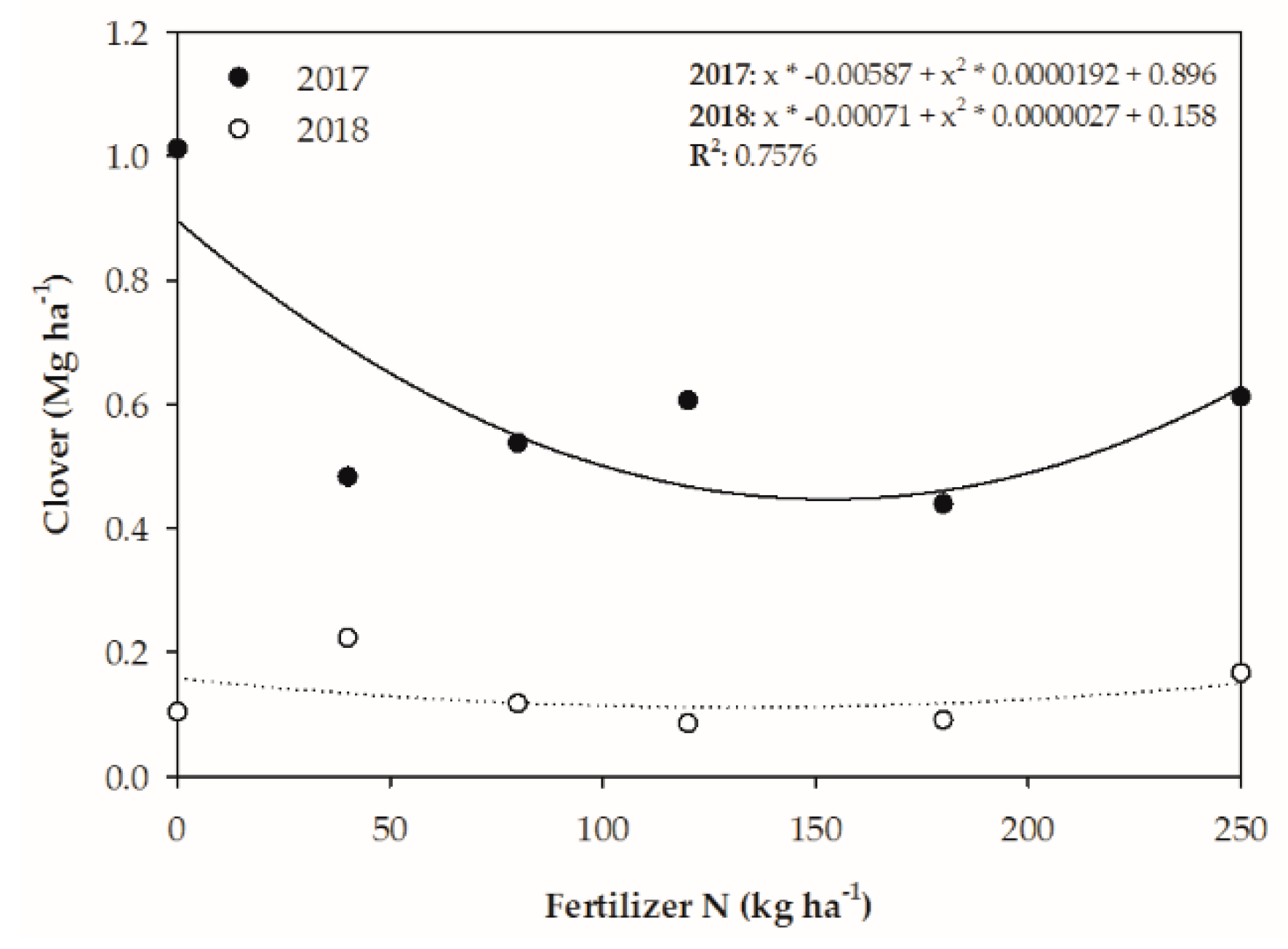
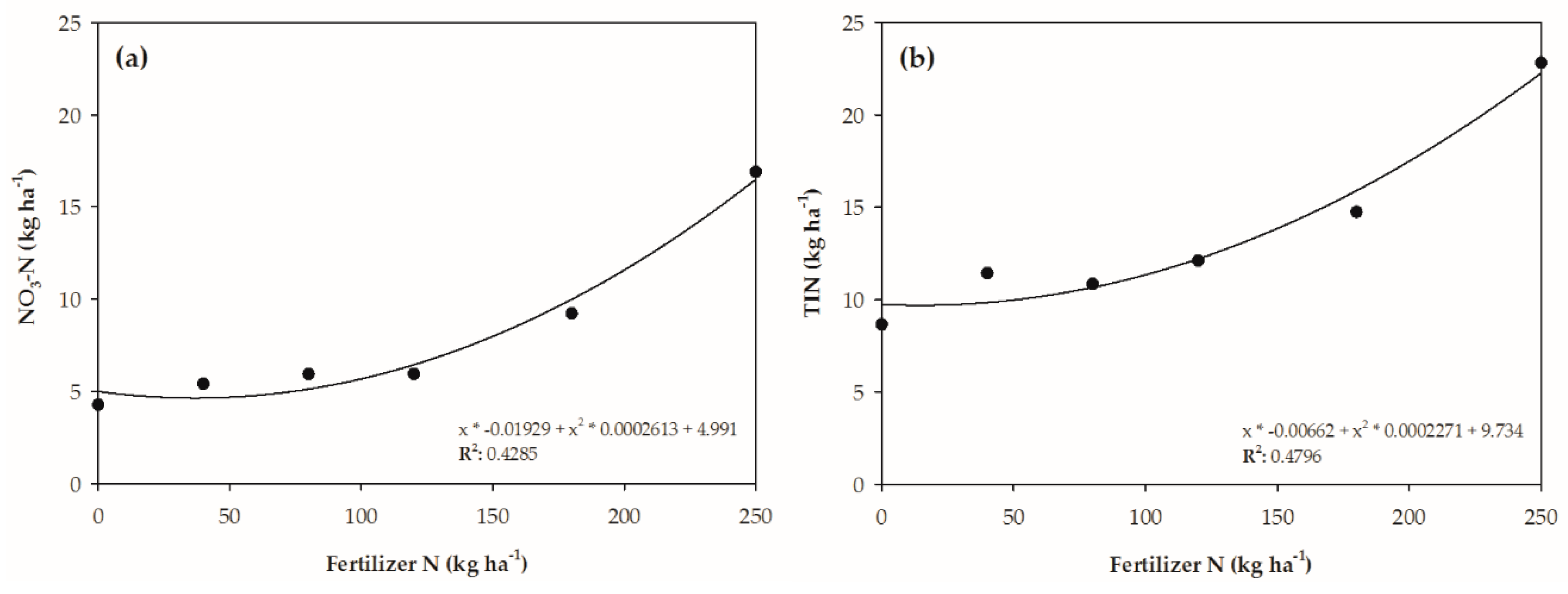
| Experiment, Growing Season | Growing Season | ||||
|---|---|---|---|---|---|
| 2018 | 2017 | 2016 | 2015 | 2011–2014 | |
| Second-year maize, 2017 | Maize † | Maize | Forage | Maize-Soybean rotation | |
| First-year maize, 2017 | Maize † | Forage | |||
| Second-year maize, 2018 | Maize † | Maize | |||
| First-year maize, 2018 | Maize † | Forage | |||
| Fixed Effect | Grain Yield | Grain N † | Stover | Stover N | Kura Clover | NH4-N | NO3-N | TIN ‡ |
|---|---|---|---|---|---|---|---|---|
| Mg ha−1 | kg ha−1 | Mg ha−1 | kg ha−1 | kg ha−1 | kg ha−1 0–0.6 m | |||
| Growing Season | ||||||||
| 2017 | 12.7 (0.2) * | 140 (3) b # | 6.75 (0.11) b | 49.6 (1.6) b | 616 (45) a | 4.63 (0.40) b | 14.99 (1.65) | 19.62 (1.85) |
| 2018 | 13.0 (0.2) | 150 (3) a | 8.52 (0.18) a | 66.5 (2.4) a | 140 (12) b | 7.93 (0.86) a | 12.35 (0.97) | 20.28 (1.38) |
| Treatment | ||||||||
| 0 ¶ | 12.8 (0.4) | 134 (4) | 7.37 (0.46) | 59.2 (6.1) | 444 (199) | 6.61 (1.72) | 7.96 (1.33) | 14.57 (2.38) |
| 40 ¶ | 12.7 (0.4) | 137 (6) | 7.41 (0.61) | 54.4 (7.3) | 330 (145) | 5.56 (1.09) | 9.31 (1.38) | 14.87 (1.96) |
| 80 ¶ | 13.1 (0.5) | 146 (8) | 7.38 (0.46) | 54.7 (3.9) | 439 (196) | 7.98 (4.87) | 10.54 (1.62) | 18.52 (5.83) |
| 120 § | 12.6 (0.5) | 140 (6) | 7.70 (0.31) | 60.4 (4.5) | 407 (147) | 6.03 (1.17) | 15.15 (4.27) | 21.18 (4.74) |
| 120 ║ | 12.7 (0.2) | 143 (4) | 7.83 (0.47) | 58.7 (4.6) | 401 (165) | 4.75 (1.26) | 10.28 (1.51) | 15.03 (2.05) |
| 120 ¶ | 13.2 (0.2) | 158 (5) | 7.58 (0.31) | 58.1 (4.1) | 361(157) | 5.99 (1.50) | 12.31 (2.22) | 18.30 (2.17) |
| 180 ¶ | 13.0 (0.3) | 150 (5) | 7.95 (0.53) | 59.6 (6.4) | 357 (119) | 6.32 (1.10) | 15.88 (3.62) | 22.21 (3.91) |
| 250 ¶ | 12.9 (0.8) | 151 (11) | 7.85 (0.33) | 59.2 (4.1) | 285 (118) | 6.97 (1.35) | 27.93 (2.85) | 34.90 (2.95) |
| Significance | ||||||||
| Growing Season | 0.311 | 0.020 | <0.001 | <0.001 | <0.001 | <0.001 | 0.203 | 0.163 |
| Treatment | 0.967 | 0.153 | 0.753 | 0.965 | 0.607 | 0.697 | <0.001 | <0.001 |
| Growing Season × Treatment | 0.959 | 0.741 | 0.565 | 0.954 | 0.723 | 0.527 | 0.002 | 0.003 |
| Fixed effect | Grain Yield | Grain N † | Stover | Stover N | Kura Clover | NH4-N | NO3-N | TIN ‡ |
|---|---|---|---|---|---|---|---|---|
| Mg ha−1 | kg ha−1 | Mg ha−1 | kg ha−1 | kg ha−1 | kg ha−1 0–0.6 m | |||
| Growing Season | ||||||||
| 2017 | 11.5 (0.4) * | 118 (6) | 6.10 (0.19) | 41.9 (1.8) b # | 593 (43) | 4.48 (0.55) b | 6.50 (0.93) b | 10.98 (1.05) b |
| 2018 | 12.9 (0.2) | 143 (3) | 8.34 (0.14) | 64.2 (2.4) a | 125 (18) | 6.18 (0.39) a | 9.02 (0.89) a | 15.19 (0.96) a |
| Treatment | ||||||||
| 0 ¶ | 9.3 (1.2) | 94 (15) | 6.18 (0.84) | 46.6 (6.7) | 558 (257) | 4.37 (0.90) | 4.27 (1.16) | 8.64 (1.78) |
| 40 ¶ | 11.1 (0.5) | 113 (9) | 6.98 (0.52) | 56.1 (9.4) | 353 (111) | 6.03 (1.50) | 5.40 (1.11) | 11.43 (2.36) |
| 80 ¶ | 11.6 (0.5) | 119 (10) | 7.18 (0.45) | 48.4 (5.2) | 327 (130) | 4.91 (0.90) | 5.93 (1.83) | 10.85 (2.63) |
| 120 § | 12.3 (0.3) | 132 (5) | 7.46 (0.51) | 54.9 (5.1) | 381 (166) | 4.79 (0.65) | 6.44 (1.27) | 11.24 (1.51) |
| 120 ║ | 13.2 (0.3) | 146 (5) | 7.29 (0.52) | 47.1 (5.5) | 253 (112) | 4.89 (1.44) | 7.96 (2.06) | 12.85 (2.63) |
| 120 ¶ | 13.2 (0.5) | 143 (8) | 7.74 (0.42) | 52.9 (4.4) | 346 (144) | 6.17 (1.62) | 5.94 (0.93) | 12.11 (1.58) |
| 180 ¶ | 13.5 (0.2) | 146 (4) | 7.63 (0.40) | 56.9 (3.8) | 265 (104) | 5.53 (1.96) | 9.22 (1.64) | 14.75 (3.12) |
| 250 ¶ | 13.3 (0.3) | 151 (4) | 7.30 (0.36) | 61.4 (5.0) | 389 (137) | 5.92 (2.01) | 16.91 (3.85) | 22.83 (2.78) |
| Significance | ||||||||
| Growing Season | <0.001 | <0.001 | <0.001 | <0.001 | <0.001 | <0.001 | <0.001 | <0.001 |
| Treatment | <0.001 | <0.001 | 0.014 | 0.124 | 0.009 | 0.944 | <0.001 | <0.001 |
| Growing Season × Treatment | <0.001 | 0.006 | 0.032 | 0.448 | 0.004 | 0.982 | 0.120 | 0.242 |
| Variable | Unit | 2017 | 2018 | ||
|---|---|---|---|---|---|
| First-Year Maize | Second-Year Maize | First-Year Maize | Second-Year Maize | ||
| EONR † | kg N ha−1 | 0 | 177 | 0 | 146 |
| Grain Yield | Mg ha−1 | 12.3 | 13.5 | 13.2 | 13.4 |
| Grain N ‡ | kg ha−1 | 126 | 142 | 141 | 150 |
| Stover Yield | Mg ha−1 | 6.2 | 7.0 | 8.5 | 8.4 |
| Stover N | kg ha−1 | 47.7 | 47.7 | 70.7 | 65.6 |
| Clover Biomass | kg ha−1 | 742 | 457 | 146 | 111 |
| Residual TIN § 0–0.3 m | kg ha−1 | 8.6 | 9.1 | 7.9 | 5.7 |
| Residual TIN 0–0.6 m | kg ha−1 | 2.4 | 4.5 | 10.3 | 10.3 |
| Management Practice | 2017 | 2018 | ||||
|---|---|---|---|---|---|---|
| Conventional | First-Year KCLM | Second-Year KCLM | Conventional | First-Year KCLM | Second-Year KCLM | |
| Spring Mowing § | 26.93 | 26.93 | 26.93 | |||
| Spring Tillage | 13.59 † | 76.78 ‡ | 76.78 ‡ | 13.59 † | 76.78 ‡ | 76.78 ‡ |
| Fertilizer N | 131.88 | 0.00 | 148.68 | 131.88 | 0.00 | 122.64 |
| Mowing § | 26.93 | 26.93 | ||||
| Grain Handling and Storage § | 231.10 | 170.53 | 186.58 | 215.88 | 182.48 | 185.09 |
| Fall Tillage § | 48.68 | 48.68 | ||||
| Raking § | 13.10 | 13.10 | 13.10 | 13.10 | ||
| Baling § | 33.36 | 33.36 | 33.36 | 33.36 | ||
| Bale Handling and Storage § | 141.16 | 158.73 | 192.33 | 191.08 | ||
| Stover Nutrient Removal ║ | 37.50 | 42.17 | 51.09 | 50.76 | ||
| Partial Management Cost | 425.25 | 526.29 | 713.26 | 410.03 | 576.08 | 672.81 |
| Growing Season | 2017 | 2018 | ||||
|---|---|---|---|---|---|---|
| Management | Conventional | First-Year KCLM | Second-Year KCLM | Conventional | First-Year KCLM | Second-Year KCLM |
| Fixed Management Cost † | 1235.47 | 1235.47 | 1235.47 | 1235.47 | 1235.47 | 1235.47 |
| Partial Management Cost ‡ | 425.25 | 526.29 | 713.26 | 410.03 | 576.08 | 672.81 |
| Grain Value § | 2221.10 | 1638.95 | 1793.20 | 2074.80 | 1753.83 | 1778.87 |
| Stover Value ║ | – | 619.13 | 696.19 | – | 843.57 | 838.07 |
| Net Return | 560.38 | 496.32 | 540.66 | 429.30 | 785.85 | 708.66 |
| Partial Economic Net Return # | – | −64.06 | −19.72 | – | 356.55 | 279.36 |
© 2019 by the authors. Licensee MDPI, Basel, Switzerland. This article is an open access article distributed under the terms and conditions of the Creative Commons Attribution (CC BY) license (http://creativecommons.org/licenses/by/4.0/).
Share and Cite
Alexander, J.R.; Baker, J.M.; Venterea, R.T.; Coulter, J.A. Kura Clover Living Mulch Reduces Fertilizer N Requirements and Increases Profitability of Maize. Agronomy 2019, 9, 432. https://doi.org/10.3390/agronomy9080432
Alexander JR, Baker JM, Venterea RT, Coulter JA. Kura Clover Living Mulch Reduces Fertilizer N Requirements and Increases Profitability of Maize. Agronomy. 2019; 9(8):432. https://doi.org/10.3390/agronomy9080432
Chicago/Turabian StyleAlexander, Jonathan R., John M. Baker, Rodney T. Venterea, and Jeffrey A. Coulter. 2019. "Kura Clover Living Mulch Reduces Fertilizer N Requirements and Increases Profitability of Maize" Agronomy 9, no. 8: 432. https://doi.org/10.3390/agronomy9080432
APA StyleAlexander, J. R., Baker, J. M., Venterea, R. T., & Coulter, J. A. (2019). Kura Clover Living Mulch Reduces Fertilizer N Requirements and Increases Profitability of Maize. Agronomy, 9(8), 432. https://doi.org/10.3390/agronomy9080432





